Contact Us. Web site contents copyrighted. All rights reserved. Made With Serif WebPlus. Home

Pinnacle Unit Manual Juniper Treatment
Sage Grouse Habitat Improvement Project
Modoc National Forest and NRCS
Doublehead Ranger District, September 2014
The measuring stick has six inch increments.
The Pinnacle Unit, 2,543 acres, is part of the Clear Lake Sage-grouse Habitat Improvement Project Phase II, 4,511 acres. The Pinnacle Unit is southeast of Clear Lake National Wildlife Refuge in Modoc County located in northeast California.
The project proposes to cut all non-old growth juniper. Since the young juniper is relatively sparse, it is to be cut, lopped and then scattered on the ground.
This is a Sage Grouse Habitat Improvement Project on public land solely managed by the Forest Service, Doublehead Ranger District, and funded by the NRCS. These collaborative projects between the Forest Service and NRCS have inherent problems since neither agency appears to take responsibility for what happens during implementation on our public land. See the Big Sage Allotment page for another Forest Service and NRCS collaboration that cut down over 500 old growth juniper on just the small part of that project which we inspected in 2012.
The actual work on the Pinnacle Unit Project was controlled by the permittee that also runs cattle on the Pinnacle Unit.
Periodic inspection and management of the project during implementation was supposed to be carried out by Forest Service personnel from the Doublehead Ranger District in order to protect the old growth juniper that was present on the project site before work began.
Based on our inspection of the Pinnacle Unit Project after implementation in September 2014, this inspection and management by the Forest Service was deficient or non-existent.

A typical grove of old growth juniper on the Pinnacle Unit, March 11, 2013, before implementation of the juniper removal project.
Excepts from the Forest Service Decision Memo:
Clear Lake Sage-grouse Habitat Improvement Project – Phase II
Decision Memo, August 9, 2013
Modoc National Forest
Doublehead Ranger District
Modoc County, CA
Introduction
“The Clear Lake Sage-grouse Habitat Improvement Project - Phase II (CL Phase II) is located in two separate areas to the south and southeast of Clear Lake National Wildlife Refuge (NWR) (refer to attached map). The project will occur on lands administered by the Modoc National Forest, but is a collaborative effort between the U.S. Forest Service (USFS), Natural Resources Conservation Service (NRCS), U.S. Fish & Wildlife Service (FWS), and private landowners.”
Project Description
“The units (Pinnacle, Lone Pine, and Horse Camp) are currently dominated by sagebrush, but juniper occurs at variable densities. Juniper trees in the units range in size from small saplings to large, old-growth trees. Old-growth juniper and trees that protect other resource values, such as raptor nests, will not be cut down. Retaining these juniper trees within the units will continue to support nesting, foraging, and other habitat components for wildlife species associated with this habitat type.”
To meet the Purpose and Need, the following actions will occur:
Pinnacle Unit: 2,543 acres
1. “Hand fell all juniper except those exhibiting old growth characteristics (see Miller et al. 2007 for typical characteristics) or those protecting other resource issues per the Sage Steppe Ecosystem Restoration Strategy (p.49).”
2. “Lop slash to a height of 30 inches or less.”
“All parties affiliated with the implementation of this project will meet prior to initiation of treatments to review the design criteria, specifications, and limiting operating periods (LOPs) to ensure retention of old growth juniper, protection of hydrological features, and protection for sensitive plant and wildlife species. Inspections will be conducted during project implementation in areas where old growth junipers are present. Pre- and post-implementation monitoring will also be completed.”
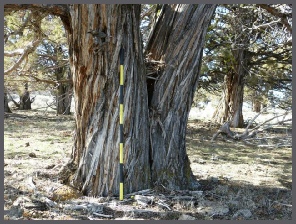
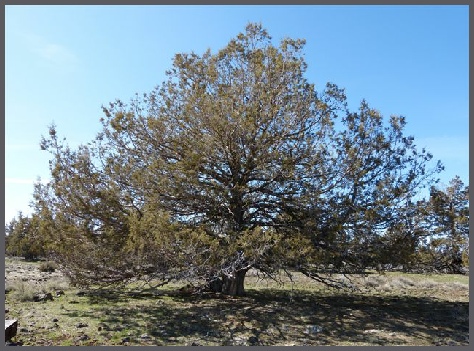
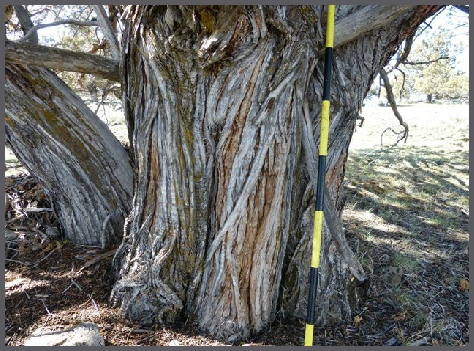
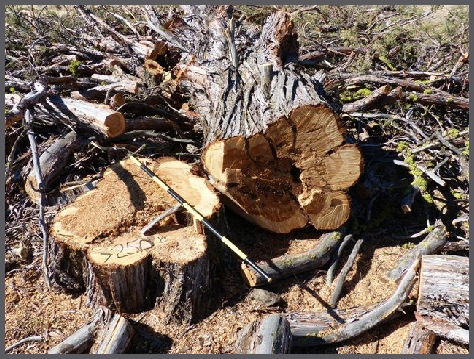
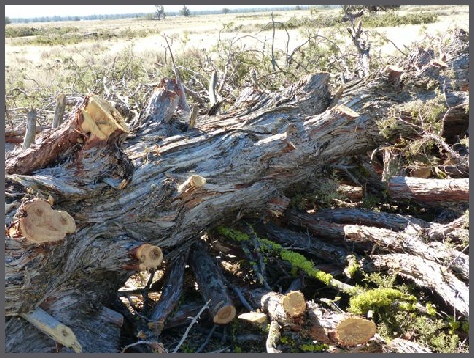
Old Growth Juniper Before, 2013, and After Implementation, 2014, Pinnacle Unit, Modoc National Forest
We took pictures and GPS locations of old growth juniper at two small sites on the Pinnacle Unit in March 2013. We returned in September 2014 and took pictures at the same GPS locations of exactly the same old growth juniper trees as in 2013. Below are before and after images of some of the old juniper that were cut down on the Pinnacle Unit under the management of the Forest Service, Modoc National Forest. The ages of the cut old juniper were estimated by counting rings and varied from about 165 years up to about 285 years at the two sites we inspected. We photographed and took GPS readings for 58 old growth juniper cut down on the 8.6 combined acres of these two small sites. The four images below are of exactly the same tree before and after implementation. The measuring stick has six inch increments.
Many of the old juniper left standing on the Pinnacle Unit Project were “limbed up” which makes them more accessible to cattle. We have seen this same pattern on Forest Service and NRCS collaborations before. The Sage Steppe Ecosystem Restoration Strategy (2008) protects old growth juniper on the Modoc National Forest. Unfortunately many old juniper were cut down or mutilated as the old tree below. The four images below are of the same old Juniper before and after.
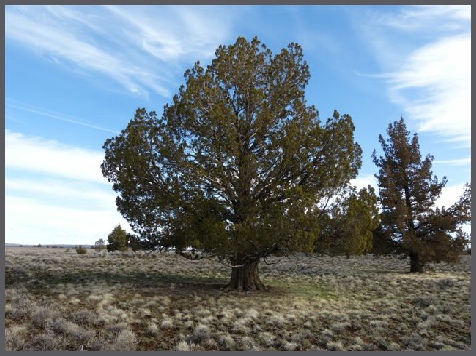
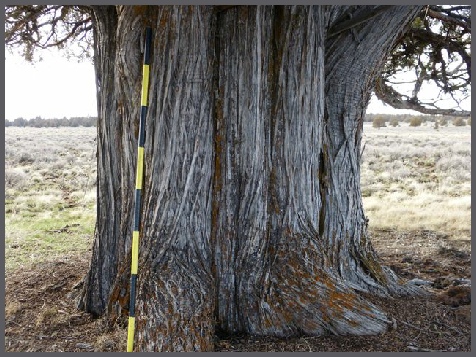
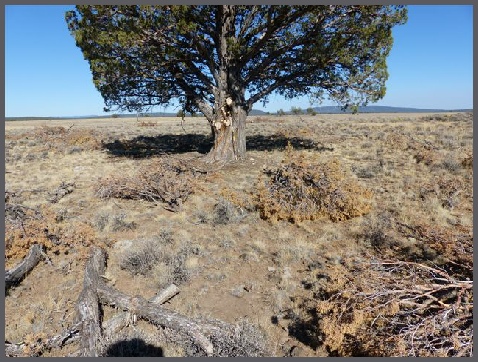
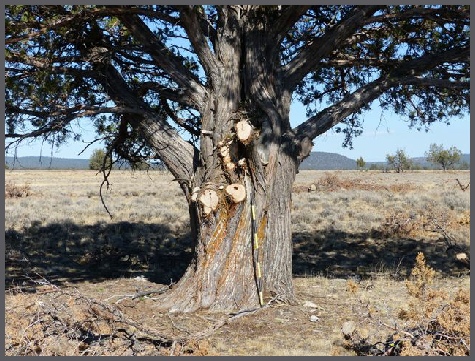
The Project Description in the Decision Memo for the Pinnacle Unit above says “ Old-growth juniper and trees that protect other resource values, such as raptor nests, will not be cut down. Retaining these juniper trees within the units will continue to support nesting, foraging, and other habitat components for wildlife species associated with this habitat type.” The old multiple trunk juniper below had two cavity nests clearly present before it was cut down during the Forest Service project. The four images below are of the same old juniper before and after implementation.
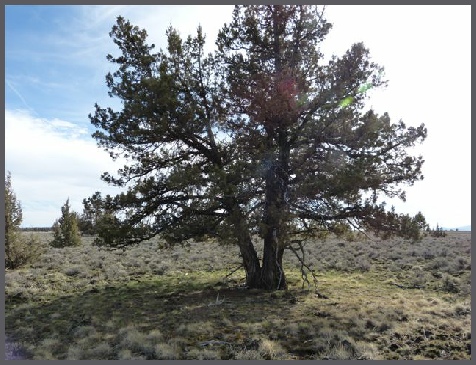
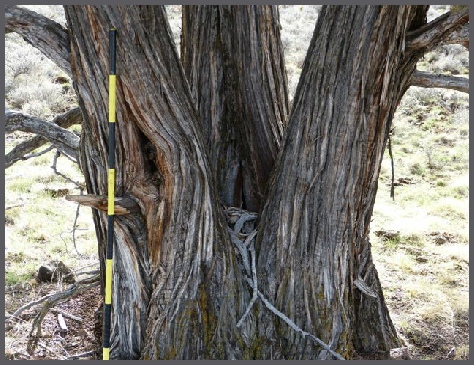
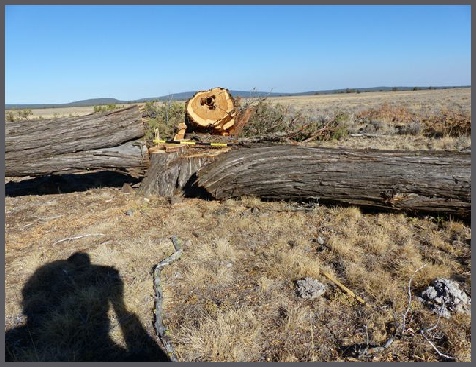

This is another obvious old growth juniper on the Forest Service and NRCS Pinnacle Unit Project that had an obvious cavity nest present before being cut down. We had a conversation with the Doublehead Ranger District Wildlife Biologist on the site of the Bumpheads Unit of Phase I just west of the Pinnacle Unit before project implementation in 2012. He was just as adamant as we were about the importance of preserving old juniper with cavity nests on all the units in the three phases of the Clear Lake Sage Grouse Habitat Improvement projects. The Wildlife Biologist from Doublehead Ranger District was in charge of the Pinnacle Unit implementation. Obviously something went very wrong during the implementation of the Pinnacle Unit. Instead of preserving the old growth juniper, we estimate this project removed or mutilated over 50% of the old juniper. The four images below are of the same old juniper before and after implementation.
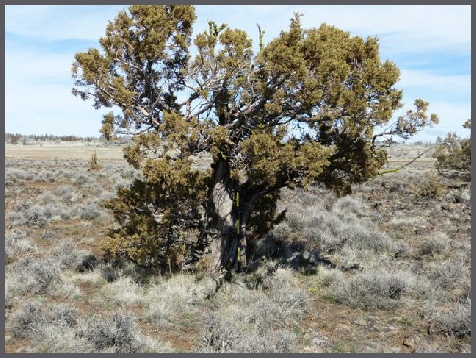
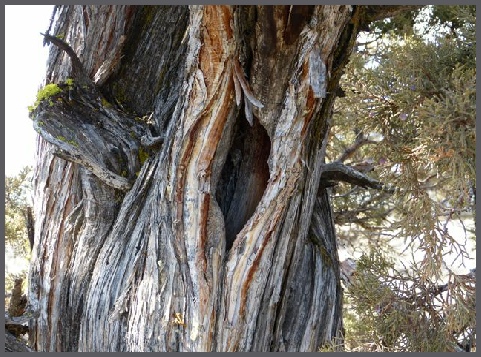

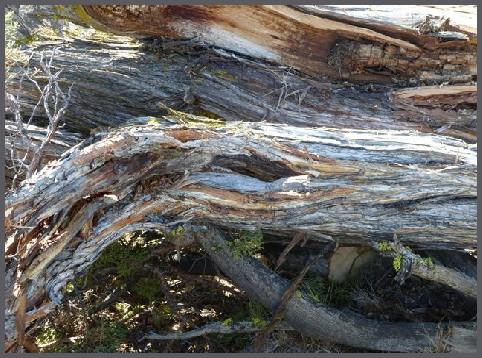
The following two images are of a different old juniper cut down on the Pinnacle Unit. It was a large old multiple trunk juniper with a diameter of about 48 inches at stump height. It also had at least two active cavity nests before it was cut down.
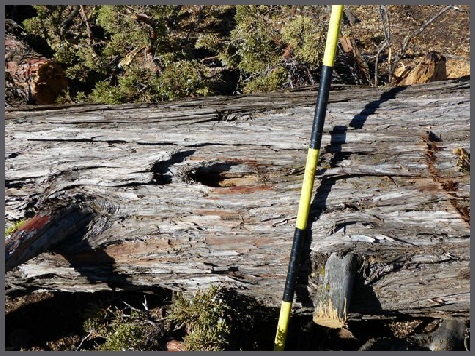
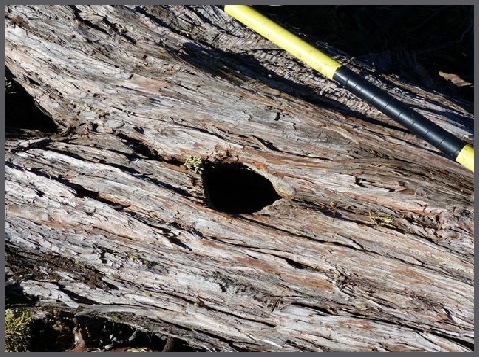
The old growth juniper on the Pinnacle Unit occur in long fingers following low rocky outcrops and in small groups of five to ten old juniper growing close together. There are a few old single trees, widely spaced, but not many. The six images below are of a group of five old juniper, ages from about 200 years to about 225 years, where the Forest Service and NRCS cut down four of them and left only one standing.


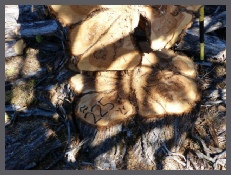
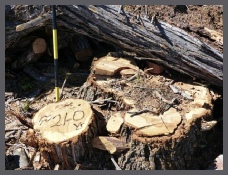
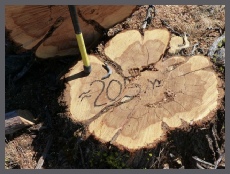
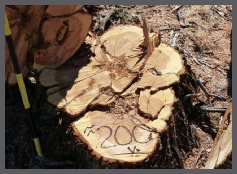
Old growth juniper with multiple trunks are often cut down on public land juniper removal projects. The federal agencies, Forest Service and BLM, have determined that an old tree needs only one old growth indicator in order to be preserved during a juniper removal project on public land. See the web page on this site, Old Juniper Characteristics, for complete details. The following two images are of an old multiple trunk juniper cut down on the Pinnacle Unit.
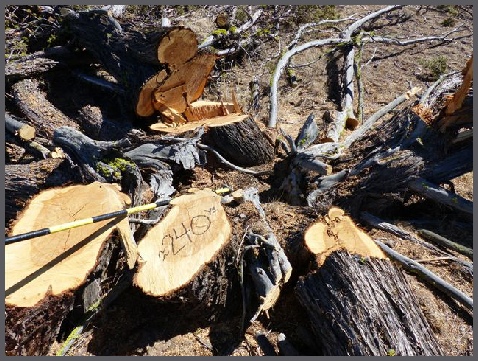
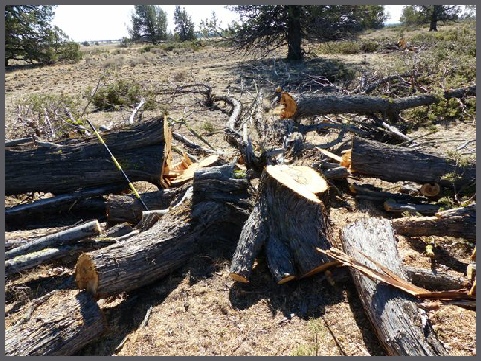
Since the Pinnacle Unit Project was funded by the NRCS, the permittee that runs cattle on this public land was also the contractor who directed the actual cutting of all the old growth juniper on this project. This is very evident when one sees all the old juniper that have been limbed up allowing cattle to access the native bunch grasses protected under the older trees. Unfortunately, after the old trees are limbed up, the cattle then use the old growth juniper as shade which extirpates all the native grasses under them. The first four before and after images below are of the same old juniper that was limbed up. The last four images are of “cow trees” on the Pinnacle Unit that show the detrimental use of old juniper by cattle on public land, no native grasses left.


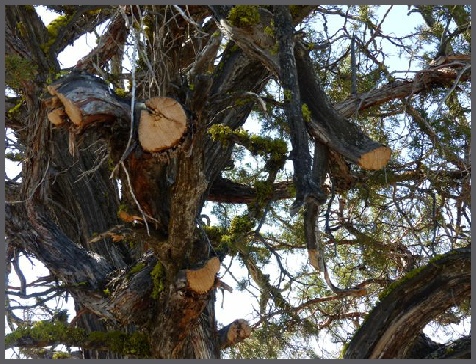
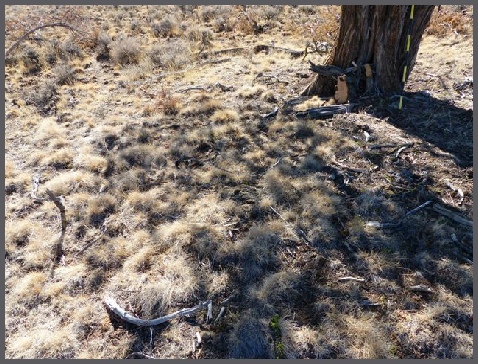
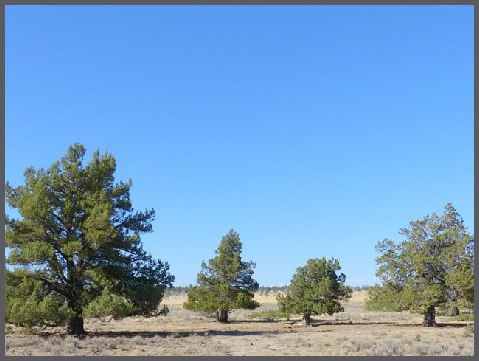
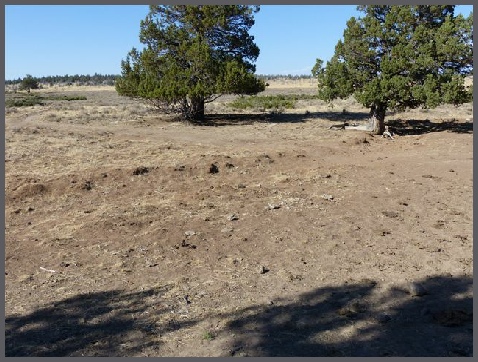
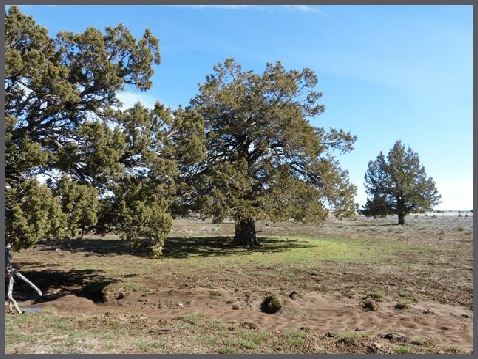
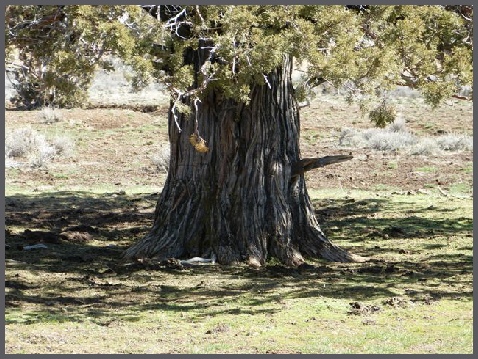
It is clear from the Forest Service Decision Memo of August 9, 2013 that the intention of the Forest Service was to remove only young invasive juniper on the Pinnacle Unit. The Decision Memo even says there will be a meeting of all parties to review the design criteria to ensure the retention of old growth juniper on the Pinnacle Unit.
We do not know whether this meeting ever took place. We do know that the Forest Service, the NRCS and the contractor/permittee did not follow the Decision Memo of August 9, 2013 that governs the implementation of this project.
We are very disappointed with the needless destruction of this valuable public resource.
This image shows the distinctive old growth bark of the old juniper in the center of the group of old juniper in the image at the right.